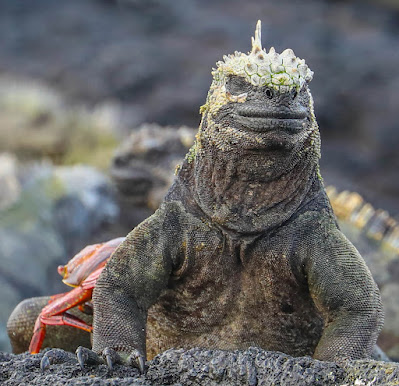The marine iguana, also known as the Galapagos marine iguana, the sea iguana and the saltwater iguana, is endemic to the Galapagos Islands. There are different subspecies found on different islands. We saw them on Isabela, Fernandina, Santa Cruz and Santiago Islands, each of which has different subspecies. Some of the differences between subspecies include: (a) differences in the spines which extend from the nape of the neck, along the back to the tail (males of each subspecies have larger spines than females) - on Fernandina the spines are more elaborate than any other; (b) differences in coloration (much greater in males than females) - some are bright pinkish/red and turqoise to black, with other markings including yellowish, ochre, greenish and gray; and (c) difference in length (males of each subspecies are significantly longer than females and weigh about twice as much) - those on larger islands are larger than those on smaller islands.




The marine iguana feeds almost exclusively on red and green algae. For their first few months, young marine iguanas mainly eat feces from large marine iguanas which helps them get the bacteria needed for digesting algae.
 |
| We only saw a few young marine iguanas (above). |
 |
| This youngster has a good illustration of the slightly webbed feet which are not much help in swimming. |
Then the younger males and females eat algae from the exposed algae in the inter-tidal zone during low tide. Large male marine iguanas, only about 5% of the total, swim offshore and dive to forage for algae underwater. They can dive as deep as 98 feet and can spend up to an hour underwater. When diving more than 23 feet, they usually spend between 15 and 30 minutes underwater. Each marine iguana has a specific feeding site that it returns to day after day.
 |
| I saw several marine iguanas swimming, but this is the only one I was able to get a photo of, as it was coming to shore. |
After emerging from the cold water the marine iguana needs to bask to regain the lost heat. The dark skin color allows it to quickly absorb heat. It has a laterally flattened tail which is the main way it propels itself through the water. The row of spines along the back provides stability while swimming and long claws allow it to hold onto rocks in strong currents and to pull itself along on the sea bottom.
 |
| The flattened tail is evident on this specimen. |
It has a blunt head and sharp teeth for grazing algae off rocks and cranial exocrine glands at the nostrils that allow it to expel excreted salt from its body in a sneezing like process. It was extraordinary to walk by and see three or four iguanas loudly sneezing through their noses and white spray in the air.
They live in coastal colonies that range from 20 to over 1,000 iguanas and generally get no further than 330 feet from the ocean. Espinoza Point, on northeastern Fernandina, appears to have the largest coastal colony, of about 1,900 marine iguanas. It was one of the most amazing sights I've ever seen. There are an estimated 200,000 to 300,000 marine iguanas and an estimated two-fifths of them (40%) live on Fernandina.
 |
| This is just a sample of the marine iguanas taking over much of the ground at Espinoza Point. |
They are often touching each other, apparently to conserve heat, but there is no social interaction, like grooming. Lava lizards will walk over them looking for flies, Sally lightfoot crabs will walk on them looking for mites and ticks (which we saw multiple incidents of) and fish will pick off moulting skin when the iguana is underwater. They commonly live close to Galapagos sea lions, which was the case at Espinoza Point, but they seem to ignore each other and have no mutual benefit.
 |
| These Galapagos sea lions were swimming in a small pool surrounded by marine iguanas. |
 |
| This sea lion is on lava slabs very near marine iquanas. |
 |
| The marine iguanas were often touching each other. |
 |
| Look at this group, they are all over each other. |
























I think the marine iguanas are one of my favorite things of the entire trip. They were just so pre-historic, so plentiful, and SO UGLY. What's not to love? I really liked the mingling of the colorful crabs and the dirt-colored iguanas. Great contrast.
ReplyDelete